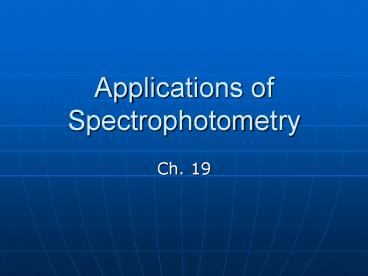Applications of Spectrophotometry PowerPoint PPT Presentation
1 / 17
Title: Applications of Spectrophotometry
1
Applications of Spectrophotometry
- Ch. 19
2
Analysis of a Mixture
- The absorbance of a solution at any wavelength is
the sum of the absorbances of all species in the
solution - A exbX eybY ezbZ.
- We can use simultaneous equations at different
wavelengths if there is little overlap at these
wavelengths in order to solve for two species,
but for more it is best to use excel
3
- When we have species whose spectra overlap, we
can use beers law, to calculate the molar
absorptivities of a standard for the species - ex Axs / bXs ey Ays / bYs
- However, we often do not know the concentrations.
We can solve for this using excel - Using the equation Acalc exbXguess
eybYguess
4
- The terms Xguess and Yguess are inserted
into the spreadsheet and the sum of the squares
(Acalc Am)2 set equal to them. Using the solver
function to vary Xguess and Yguess to
minimize the sum of the squares, we can compute
the most likely concentrations.
5
- When spectra are well resolved, we use a matrix
determination of the functions - A exbX eybY
- A exbX eybY
- in order to compute the concentrations of X and
Y. - Often one absorbing species, X, will convert to
another absorbing species, Y, which will result
in a very distinct pattern in which the graphs
cross at a point known as the Isosbestic point
6
(No Transcript)
7
Measuring an Equilibrium Constant The Scatchard
Plot
- Equilibrium constants are measured by activities.
For example, for the equilibrium P X PX, - K PX/PX
- If there were a series of solutions in which
increments of X are added to a constnant amount
of P, so that P0 is the total concentration of P, - P P0 -PX
8
- Substituting this into the equilibrium
expression, and rearranging terms, we get - PX/P KP K(P0 - PX)
- Using spetrophotometric absorbance to measure PX,
we get - A epxPX epP
- Substituting P P0 -PX again, we get
- A epxPX epP0 -epPX
9
- Since epP0 is A0,
- A PX (epx -ep) A0 ? PX?A/?e
- So that
- ?A/X K?eP0 - K?A
10
Flow injection analysis
- In flow injection analysis, a sample is injected
into a moving liquid stream to which various
reagents can be added. After a suitable time, the
reacted sample reaches a detector, which is
usually a spectrophotometric cell. Flow injection
is widely used in medical and pharmaceutical
analysis, water analysis, and industrial process
control - A key feature of Flow injection analysis is
rapid, repetitive analysis.
11
Immunoassays and Aptamers
- Immunoassays, an important application of
fluorescence employs antibodies to detect
analytes. The analyte will bind to an antibody,
and then a second antibody, which has an enzyme
that results in either a colored or fluorescent
product attached to it, binds to the analyte.
12
(No Transcript)
13
(No Transcript)
14
Time Resolved Immunoassays
- The sensitivity of fluorescence immunoassays can
be enhanced with time-resolved meausrements of
luminescence from the lanthanide ion Eu3. - A chelatin group binds the Eu3 to the antibody
after completing all required steps, the pH is
lowered and the Eu3 is released as an ion in the
presence of a soluble chelator, which attracts
metal to the solution. Strong luminescence from
the metal is easily detected
15
(No Transcript)
16
Aptamers
- Aptamers are 15-40 base pieces of DNA or RNA
that strongly and selectively bind to a specific
molecule. An aptamer for a desired target
molecule is chosen from a pool of random DNA or
RNA sequences by successive cyclings of binding
to the target, removing unbound material, and
replicating the bound nucleic acid. . This
aptamer then behaves as a custom made, synthetic
antibody.
17
Sensors based on Luminescent Quenching
- Luminescence intensity is proportional to the
concentration of the emitting species if
concentrations are low enough. We can measure
some analytes, such as O2, by their ability to
quench the luminescence of another compound. - In a molecular beacon, fluorescent and
quenching groups are built onto one molecule of
DNA or RNA. When the beacon binds to
complementary molecules of DNA or RNA, the
fluorescent group separates from the quencher and
the molecule becomes strongly fluorescent

